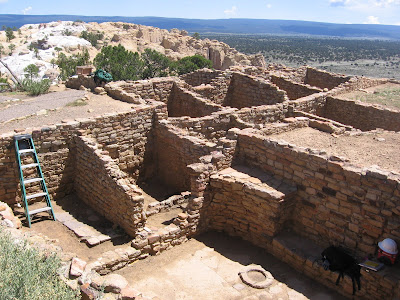The
El Moro Trail is a 2 mile loop that visits the historic Inscription Rock and the Atsinna Pueblo ruins site at El Moro National Monument in northwest New Mexico. El Moro is a
sandstone bluff or headlands that rises above the Pinon Pine and Juniper surrounding landscape.

For centuries travelers have stopped at El Moro for the
pool of cool water that collects in a pocket on one side of the bluff. There isn’t a spring here, but the pool holds water throughout the year. The visitors here left their marks in the sandstone walls near the pool. Now there more than 2000 historic and pre historic inscriptions.
There are 23 interpretive stops on the
Inscription part of the trail and a trail guide that gives some of the history of those who stopped here. Several of the main trees of the area are also identified with signs, making this a botany trail also. I noticed that there are more species of Juniper trees here than are usually seen in one place.

Some of the older American Inscriptions are associated with the U.S, Army scouting party surveying a route from Ft. Smith Arkansas to the Colorado River in 1857. This survey party was also testing to see if camels could be used more effectively in the desert environment of the southwest. Many of the inscriptions are white on white and hard to see. In the early years of the park, some efforts were made to darken the writing with carbon.

One of the oldest Spanish inscriptions is from the first governor of New Mexico, Don Juan de Onate in 1605. The Spanish inscriptions often include “
paso por aqui”- passed through here. I notice that the Spanish inscriptions here tend to be in a swirly script, like hand writing. There are also Ancestral Pueblo petroglyphs in several places featuring mountain sheep and handprints and there is one bear paw.

After the 0.5 mile Inscription portion of the trail, the route climbs to the
top of the bluff giving good views over the surrounding countryside. It looks there is a small vertical arch forming near the top of the bluff. Arriving near the top there are some wall sections visible from a large unexcavated ruins site. The trail over the bare sandstone was marked by chipping parallel lines, forming a lane, and there are many steps carved into the rock.

On the bluff top, the trail winds around the edge of the sandstone bluff, making towards the
Atsinna Pueblo ruins site. This is a very large site with maybe 800 rooms, but only a few are excavated. This site is thought to have been occupied from 1275 to 1400 by the ancestors of the Zuni people who have a reservation in the area.

Among the 18 excavated rooms is a
Great Kiva. The dates of occupation here are a little later than many other sites in the Four Corners region. Most of the Mesa Verde sites to the north are thought to have been abandoned by the time that Atsinna was just being constructed.
This trail takes about 1:30 hours depending on how long you linger at the many points of interest. There are many benches for resting and enjoying the views. I walked the trail in late June on a 78 F degree day and carried one liter of water. The bluff top is about 200 feet above the inscription covered base.